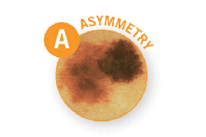This Spot Will Not Go Away Should I See A Dermatologist
As a board-certified dermatologist, my patients ask me, “When should I be concerned that a mole is actually skin cancer?” You may have heard of the ABCDE of melanoma (Asymmetry, Border, Color, Diameter, Evolution). These are helpful skin cancer warning signs for assessing spots on the skin. If you have a spot that violates any of these, it’s best to let a board-certified dermatologist take a look.
That said, I think we are asking a lot of our patients when we ask them to use these criteria. After all, you are not trained to be a dermatologist! So, let me simplify it a bit for you. I think the most important of these skin cancer warning signs is E for evolution. If you have a spot that is changing or growing (an ugly duckling, as I like to call them) or if you notice a spot that makes you suspicious for any reason, see a dermatologist.
You may not know how to recognize the different types of skin cancer. Let me tell you some of the basics of the most common kinds of skin cancer.
MOST COMMON TYPES OF SKIN CANCER
BASAL CELL CARCINOMA
Basal cell carcinoma (BCC) is the most common type of skin cancer. It is from chronic sun damage. So they usually grow in areas that have the most cumulative exposure to the sun (or tanning beds). The most common areas include the face, ears, neck, shoulders, arms, and the back of the hands. BCCs are usually skin-colored or pink. Sometimes the skin can break down and form an ulcer. It is also common for BCCs to bleed with minimal trauma and form scabs. Metastasis is very rare in BCC but it is best to remove these early to keep the surgical wound small.
SQUAMOUS CELL CARCINOMA
Squamous cell carcinoma (BCC) is also from chronic sun damage so they most commonly occur in the same areas as BCC. SCCs are typically skin-colored or pink. Whereas BCCs tend to be smooth and “pearly,” SCCs tend to be scaly or have a white plug in the middle. As far as aggressiveness, SCCs fall in between BCC and melanoma. While most SCCs have a low risk of metastasis, some are more aggressive and do carry the risk of metastasis and death. It is important to treat these early before they have a chance to spread.
MELANOMA
Melanoma is a type of skin cancer we want to catch early because it tends to be aggressive and spread to other parts of the body. It is often the result of chronic sun damage as well, so the same areas as BCC and SCC are common areas for melanoma to occur. That said, some people carry a genetic predisposition to develop melanoma and they can occur anywhere on the skin or mucosa (e.g. eyes, mouth).
Melanomas are usually brown but occasionally are skin-colored, pink, or can look more blue or black than brown. Again, the most important factor is E for Evolution. If you have several moles and notice a mole that is new or changing, see a dermatologist. We are trained to recognize these irregularities and can use a dermatoscope-an instrument that allows us to magnify the lesion to look at specific details that can help us make a diagnosis.
ABCDE OF MELANOMA
For those of you who would like more details on the skin cancer warning signs ABCDE algorithm, here are a few details:





Asymmetry: One half of the spot is unlike the other half
Border: The spot has an irregular, scalloped, or poorly defined border
Color: The spot has varying colors from one area to the next, such as shades of tan, brown or black, or areas of white red or blue
Diameter: Larger than 6 millimeters
Evolution: The spot is changing in size, shape, or color
CHECKS For Skin Cancer Warning Signs
If you have not had a skin check in the past year, come see me and we will make sure to treat any concerning areas before they become a serious problem. I often find spots that should be treated that patients weren’t even aware they had.
I have patients tell me, “Sorry to waste your time for something so minor.” In reality, they very much did the right thing. It’s much better for me to take a quick look and tell you that you do not need to worry about something than for you to reassure yourself that it’s okay and then find out years later that it is a skin cancer.
ABOUT DR. INNES
Dr. Innes is a board-certified dermatologist in Layton, Utah. If you feel you have sun damage and would like a skin check, call 801-773-4865 or schedule online by going to tannerclinic.com/appointments. You can learn more at https://tannerclinic.com/dermatology or on social media (Follow @thefrugalderm on Facebook, Instagram, and Youtube).

